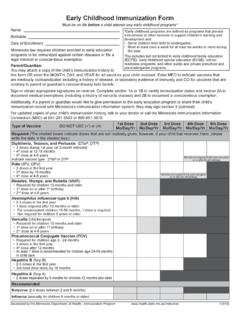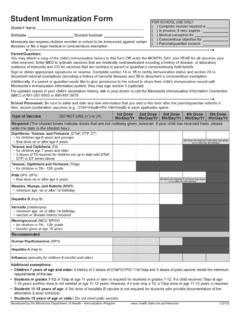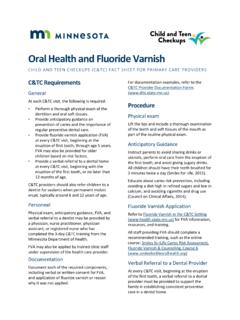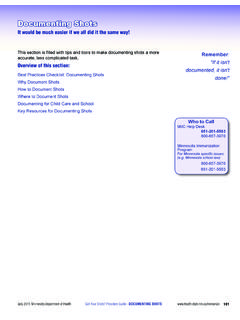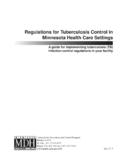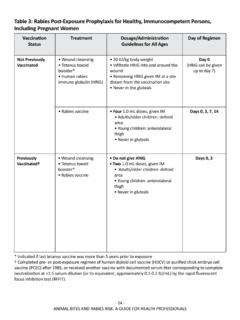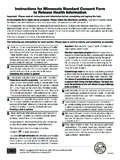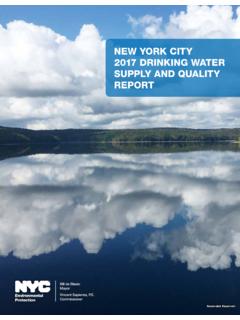Transcription of Well Owner’s Handbook - Minnesota Department …
1 well owner s Handbook A Consumer s Guide to Water Wells in Minnesota well Management Section Environmental Health Division Minnesota Department of Health Fourth Edition. (updated January 2014) well owner S Handbook A Consumer s Guide to Water Wells in Minnesota Table of Contents Introduction .. 3 groundwater and Wells .. 4 well Construction .. 6 Types of Wells .. 6 Who May Construct a well .. 7 Required Permit or Notification .. 8 well Location .. 8 How a well is Constructed .. 10 The Water System .. 12 Pumps .. 13 Pitless Adapters and Pitless Units .. 15 Pressure Tanks.
2 16 A Safe well .. 17 well Disinfection .. 17 Water Testing .. 18 The Total Coliform Bacteria Test .. 18 The Nitrate Test .. 20 Tests for Other Contaminants .. 21 Water Treatment .. 25 well Maintenance .. 30 Sealing Unused Wells .. 31 Record Keeping .. 32 well Disclosure Upon Sale of Property .. 33 Troubleshooting .. 34 Additional Information .. 35 Minnesota Department of Health District Offices .. 35 Delegated well Programs .. 36 3 Introduction Are you thinking about having a new water well drilled? Do you have questions about an existing well ? Perhaps you are building a new home or replacing an existing water supply.
3 Perhaps you have previously lived in a city with a public water supply system and you now have moved to a home in a rural area that uses a private well for its water supply. Whatever the case, this Handbook contains important information you should know about: Minnesota s groundwater . well construction and protection. well operation and maintenance. well water safety and testing. Sealing unused wells. What is Most Important? Learn about your well and the components of your water system. Wells don t last forever. If your well is old, have it inspected by a licensed well contractor (pages 6-16).
4 Collect a water sample from your well on a regular basis and have it tested for total coliform bacteria and nitrate. If you are having a new well constructed, a water sample is required to be taken from a new well by the licensed well contractor (pages 18-20). Test your well water at least once for arsenic (page 21). Reduce your potential exposure to lead in drinking water by letting the faucet run for 30-60 seconds before using the water for drinking or cooking, especially after the water has not been used for more than six hours (page 23). Maintain your well in a sanitary condition.
5 The well should have a waterproof cap, and the well casing should extend at least 1 foot above the surface of the ground. Keep septic systems, fertilizers, gasoline, fuel oil, and chemicals away from your well (page 30). Have any wells that are no longer in use permanently sealed by a licensed well contractor or a licensed well sealing contractor (page 31). 4 groundwater and Wells Minnesota s drinking water comes either from surface water (lakes, streams, or rivers) or from groundwater . Surface water is more vulnerable to contamination and requires extensive testing and treatment to assure that it is safe to drink.
6 groundwater obtained from a well is usually safe to drink without treatment, if the well has been properly constructed and maintained. Seventy percent of the people in Minnesota obtain their drinking water from groundwater , either from private or public wells. groundwater and surface water are both part of the hydrologic cycle, which is illustrated in Figure 1. Water rises from the earth s surface as evaporation and falls to the earth as precipitation, in the form of snow or rain. Water that falls on the ground either moves over the ground as runoff or down through the soil to the saturated zone through infiltration and then through an aquifer to an area of discharge, such as a river, lake, or pumping well .
7 FIGURE 1 The Hydrologic Cycle. SOURCE: Modified from Using Ground-Water Data for Water Planning, Educational Series-8, 1987, Minnesota Geological Survey. As the name implies, groundwater is found beneath the land surface in cracks and crevices in bedrock, or in pore spaces, which are the small spaces between soil or rock particles in sand and gravel deposits. Surface water becomes groundwater when it seeps downward to the saturated zone. The saturated zone begins at the point where the pore spaces and cracks in the soil, sediment, or rock become completely filled with water.
8 The top of this zone is called the water table. An aquifer is a layer of sediment, such as sand or gravel, or a layer of rock, such as sandstone, that stores and transmits water to a well . A confining layer is a layer of sediment or rock that slows or prevents the downward movement of water a thick layer of clay is an example of a confining layer. Geologic conditions vary greatly in different parts of Minnesota . As a result, well depth, well construction, and natural water quality also vary. Most wells in Minnesota draw water from sand and gravel layers that were deposited by the melting of glaciers during past ice ages.
9 Glacial deposits range in thickness from very thin or absent in the eastern part of the state to over 1,000 feet in the west. Wells in southeastern and east central Minnesota , including the Twin Cities metropolitan area, often draw water from sandstone and limestone rock formations which underlie the glacial deposits. In northeastern Minnesota , the St. Cloud area, and the Minnesota River Valley, wells often draw water from fractured rocks such as granite. Information concerning the geology and groundwater resources in your area may be obtained from a licensed well contractor, the Minnesota Department of Health offices listed on page 35, delegated well programs listed on page 36, or the Minnesota Geological Survey at 612-627-4784.
10 The quality of groundwater depends on the type of soil, sediment, or rock through which the water is moving, the length of time water is in contact with geologic materials, and whether any contaminants are present. Gases, minerals, and other chemicals may dissolve into water as it moves underground. The quality of Minnesota groundwater as it relates to human health is generally very good. Bacteria, viruses, and many chemical contaminants are removed or filtered from the water as it moves downward through silt, sand, and gravel deposits. Observing minimum isolation distances (also known as setback or separation distances) from contamination sources (Figure 2) and well construction standards required under Minnesota Rules, Chapter 4725 (the well Code ) will help assure that the quality of the well water remains high.

